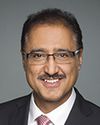Thank you for inviting me. I very much appreciate it.
What I thought I would do in the five minutes that I have is to give you a little bit of an overview of our company, what we've been doing, and how we can work together on some of the initiatives, going forward.
Firstly, as mentioned, I'm with QNX Software. I started with QNX in 1987. QNX is an Ottawa-based company—with over 400 people based in Ottawa—and it has been since its inception. We provide core software that you will find in everything from wind turbines, gas turbines, traffic lights in Ottawa, MRI machines, and laser eye surgery equipment. Atomic Energy of Canada uses our software for nuclear reactor monitoring, and General Electric uses it to monitor the energy grid. We're at the heart of Cisco routers for communication, the largest routers in the world. We really are at the heart of a lot of the infrastructure that we all interact with every day.
We don't get a lot of publicity, but we've started to involve ourselves much more publicly, I'll say, in some of our activities. Thanks to government efforts, we've been able to advertise those and bring about a lot more awareness on a global basis, quite frankly.
Our primary market today is the automotive market, and specifically the automotive market. We're in over 60 million vehicles. We're at the heart of every OnStar system that ships. We have number one market share in infotainment, so if you have a display screen in the middle of your vehicle, chances are it's running QNX software.
I should mention that QNX was acquired by BlackBerry in 2010, so we're a wholly owned subsidiary of BlackBerry.
As far as vehicles are concerned, there are telematics; digital instrument clusters, because they're moving from analog to digital; infotainment systems; and now safety systems in cars. There is tremendous disruption in the automotive market today. The architecture and nature of vehicles is changing tremendously, and that is manifesting itself in the form of announcements and initiatives such as at General Motors and what they announced in terms of what they're doing in Oshawa. There are a lot of initiatives at a provincial level and in private industry. You're seeing investments from Ford, for instance, and from GM into Lyft, into ride sharing and into shared mobility. The automotive industry, and to an extent, transportation, is undergoing incredible disruption.
There is a tremendous opportunity to collaborate among the private industry, academia, and government, to take advantage of this disruption and truly be a world leader. We can do this, not just here in Ottawa but in Ontario and in Canada. We have the technology and we have the innovation. The heart of it is security and communications, for which we're very well known. If you think of BlackBerry, they're second to none in terms of security. If you think of communications and the expertise that we have there....
When I was thinking of infrastructure, one of the things I wanted to put forward was that the definition of infrastructure should, perhaps, be broader than the way most people think of infrastructure. It should involve technologies and communications—and not necessarily roads and bridges and whatnot that probably most people think of today—because transportation in the future is going to change. There are a number of reports that will say that there will be more vehicles or that there will be fewer vehicles. At the end of the day, our job—we offer foundation software—will be making vehicles much safer.
If you think of vehicles today, there are 1.5 billion vehicles on the road today. In Canada, there are roughly 2,000 people who die because of traffic accidents. We can make vehicles safer. We can make vehicles more secure. We can have vehicles talk to each other. We can enable first responders to get more information more quickly. There are so many advantages from an environmental perspective, and we can enable greater mobility for all ages.
There really is a tremendous opportunity from a QNX-BlackBerry perspective. We're working with all the major automakers and all the major suppliers to automakers. We're right at the heart of these next-generation vehicles that, essentially, are going to be a point or a sensor that you can actually gather information from.
We can make the roads a lot more efficient, and we can make transportation much more available. We can do it through technology and through technology that can be developed and commercialized here in Canada, understanding that automotive and transportation are definitely global industries. Obviously, we need tremendous collaboration between the U.S. and Canada, which I think we have and have had.
I can talk a little bit about some of the initiatives there. They have a vehicle-to-vehicle communication guideline that they've put forward for something called DSRC, or vehicle-to-vehicle communications. They're going to mandate that the equipment be in cars starting in 2021, and all vehicles will need to be equipped with that technology for 2023.
Essentially, vehicles will have to broadcast where they are, how fast they're going, what direction they're going in, and what position they're in. Think of, say, a simple scenario where maybe you have a blind intersection. If you have vehicles talking to each other, all of a sudden they can become aware of each other, and then you can get into warning the driver of an unsafe situation. As we look at technology going forward, if the driver doesn't take action, the vehicle can take action, in other words apply the brakes, for instance.
This could be a very long topic and I'm absolutely thrilled to have this kind of discussion. The message I want to leave you with is that transportation and automotive is going through a disruption, and we have a real opportunity.
One of the things we did recently—and I'd like to thank Prime Minister Trudeau again—was that at QNX, we actually opened and launched an autonomous vehicle innovation centre, putting autonomous vehicles, connected vehicles, and safe vehicles on the map right here in Ottawa, Canada. That was a thrill.




